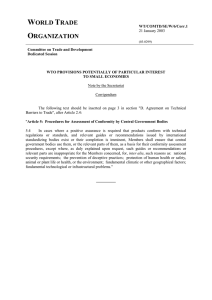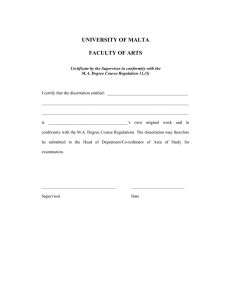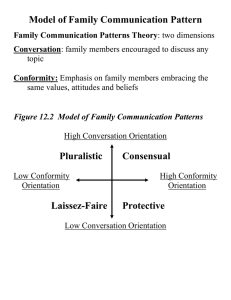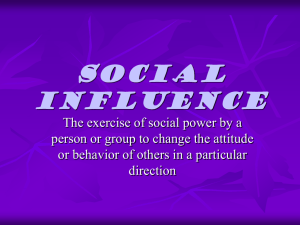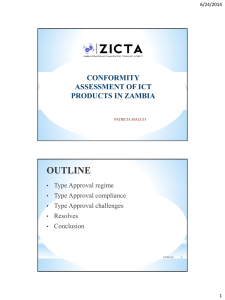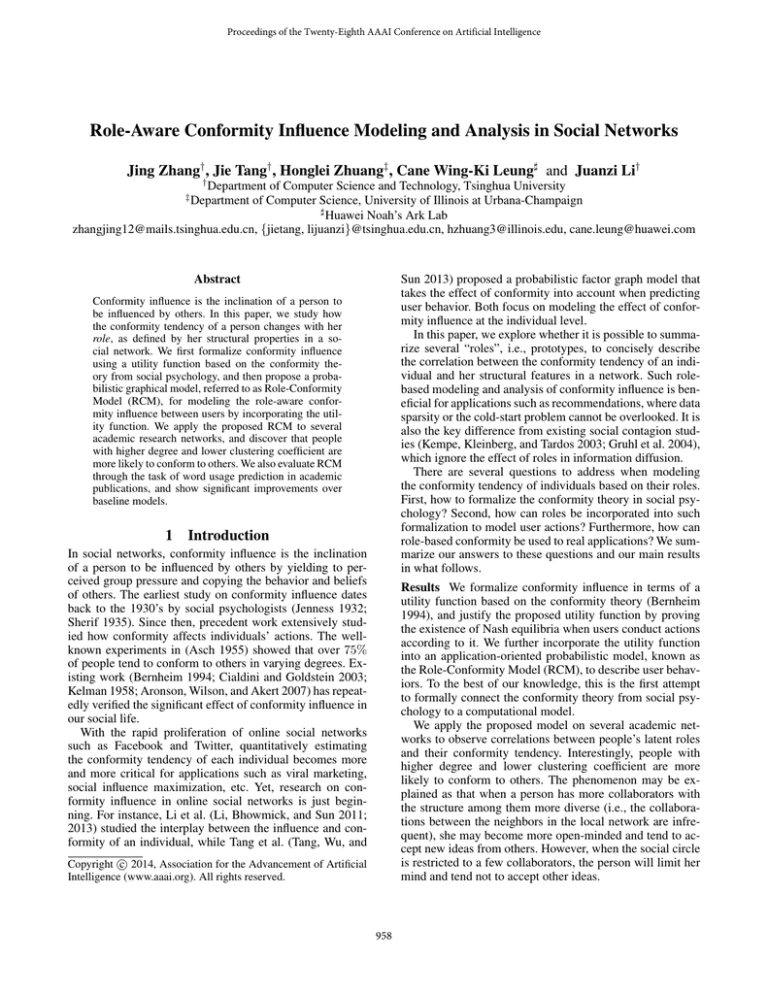
Proceedings of the Twenty-Eighth AAAI Conference on Artificial Intelligence
Role-Aware Conformity Influence Modeling and Analysis in Social Networks
Jing Zhang† , Jie Tang† , Honglei Zhuang‡ , Cane Wing-Ki Leung] and Juanzi Li†
Department of Computer Science and Technology, Tsinghua University
Department of Computer Science, University of Illinois at Urbana-Champaign
]
Huawei Noah’s Ark Lab
zhangjing12@mails.tsinghua.edu.cn, {jietang, lijuanzi}@tsinghua.edu.cn, hzhuang3@illinois.edu, cane.leung@huawei.com
‡
†
Abstract
Sun 2013) proposed a probabilistic factor graph model that
takes the effect of conformity into account when predicting
user behavior. Both focus on modeling the effect of conformity influence at the individual level.
In this paper, we explore whether it is possible to summarize several “roles”, i.e., prototypes, to concisely describe
the correlation between the conformity tendency of an individual and her structural features in a network. Such rolebased modeling and analysis of conformity influence is beneficial for applications such as recommendations, where data
sparsity or the cold-start problem cannot be overlooked. It is
also the key difference from existing social contagion studies (Kempe, Kleinberg, and Tardos 2003; Gruhl et al. 2004),
which ignore the effect of roles in information diffusion.
There are several questions to address when modeling
the conformity tendency of individuals based on their roles.
First, how to formalize the conformity theory in social psychology? Second, how can roles be incorporated into such
formalization to model user actions? Furthermore, how can
role-based conformity be used to real applications? We summarize our answers to these questions and our main results
in what follows.
Conformity influence is the inclination of a person to
be influenced by others. In this paper, we study how
the conformity tendency of a person changes with her
role, as defined by her structural properties in a social network. We first formalize conformity influence
using a utility function based on the conformity theory from social psychology, and then propose a probabilistic graphical model, referred to as Role-Conformity
Model (RCM), for modeling the role-aware conformity influence between users by incorporating the utility function. We apply the proposed RCM to several
academic research networks, and discover that people
with higher degree and lower clustering coefficient are
more likely to conform to others. We also evaluate RCM
through the task of word usage prediction in academic
publications, and show significant improvements over
baseline models.
1
Introduction
In social networks, conformity influence is the inclination
of a person to be influenced by others by yielding to perceived group pressure and copying the behavior and beliefs
of others. The earliest study on conformity influence dates
back to the 1930’s by social psychologists (Jenness 1932;
Sherif 1935). Since then, precedent work extensively studied how conformity affects individuals’ actions. The wellknown experiments in (Asch 1955) showed that over 75%
of people tend to conform to others in varying degrees. Existing work (Bernheim 1994; Cialdini and Goldstein 2003;
Kelman 1958; Aronson, Wilson, and Akert 2007) has repeatedly verified the significant effect of conformity influence in
our social life.
With the rapid proliferation of online social networks
such as Facebook and Twitter, quantitatively estimating
the conformity tendency of each individual becomes more
and more critical for applications such as viral marketing,
social influence maximization, etc. Yet, research on conformity influence in online social networks is just beginning. For instance, Li et al. (Li, Bhowmick, and Sun 2011;
2013) studied the interplay between the influence and conformity of an individual, while Tang et al. (Tang, Wu, and
Results We formalize conformity influence in terms of a
utility function based on the conformity theory (Bernheim
1994), and justify the proposed utility function by proving
the existence of Nash equilibria when users conduct actions
according to it. We further incorporate the utility function
into an application-oriented probabilistic model, known as
the Role-Conformity Model (RCM), to describe user behaviors. To the best of our knowledge, this is the first attempt
to formally connect the conformity theory from social psychology to a computational model.
We apply the proposed model on several academic networks to observe correlations between people’s latent roles
and their conformity tendency. Interestingly, people with
higher degree and lower clustering coefficient are more
likely to conform to others. The phenomenon may be explained as that when a person has more collaborators with
the structure among them more diverse (i.e., the collaborations between the neighbors in the local network are infrequent), she may become more open-minded and tend to accept new ideas from others. However, when the social circle
is restricted to a few collaborators, the person will limit her
mind and tend not to accept other ideas.
Copyright c 2014, Association for the Advancement of Artificial
Intelligence (www.aaai.org). All rights reserved.
958
when vk+1 joined a k-network that has already arrived at a
Nash equilibrium.
We assume that the preferred selection of vk+1 is 1, i.e.,
ŷk+1 = 1. The proof is the same when ŷk+1 = 0. Given an
existing k-network, we denote the number of vk+1 ’s neighbors with y = 1 as N 1 , and the number of vk+1 ’s neighbors
with y = 0 as N 0 . Thus, the utility of vk+1 is calculated as:
⇢
(1
) + N 1 if yk+1 = 1
f (vk+1 ) =
if yk+1 = 0
N0
We evaluate the proposed RCM through the task of word
usage prediction, and results indicate that our model performs much better (+3.6-4.1% in terms of average MAP and
+7.1-47.4% in terms of average AUC) than the basic TF-IDF
and PLSA.
2
Formalizing Conformity
In this section, we formalize conformity influence based on
the conformity theory from social psychology in terms of a
utility function, and prove the existence of Nash equilibria if
all users in a network behave according to it.
The utility of a neighbor vi of vk+1 is represented as:
X
f (yi ) = (1 ) d(yi , ŷi )+
d(yi , yj )+ d(yi , yk+1 )
Conformity utility function The conformity theory suggests that heterogeneous preferences do result in heterogeneous behaviors (Bernheim 1994). Everyone in a group expresses her own individuality. Yet, even individualists succumb somewhat to the desire for status (esteem or popularity) and shade their choices toward the social norm. This is
because people seeking status care about how someone else
feels about them through their actions. They are therefore
willing to suppress their individuality and conform to the
social norm, worrying that even small departures from the
social norm may seriously impair their popularity.
We formalize the conformity theory in terms of a utility
function. We use a binary value to represent whether a user
vi adopts an action (yi = 1) or not (yi = 0). Given the decision yi , we model the utility vi obtained from her decision
from two aspects. One is the individual’s intrinsic utility in
the absence of all other neighbors, the other is the esteem
acquired through conforming:
X
f (yi ) = (1
d(yi , yj ) (1)
i ) d(yi , ŷi ) + i
j2N (i)
Suppose (1
) + N 1 > N 0 , vk+1 will decide to
adopt the action (i.e., yk+1 = 1). The proof is the same when
(1
) + N 1 < N 0.
We observe that the neighbors with yi = 1 will not change
their decisions. Otherwise, the utility obtained from the knetwork will decrease because the Nash equilibrium is damaged, and the utility obtained from vk+1 will also decrease
because yi is changed differently from yk+1 .
For the neighbors with yi = 0, if they change their decisions, the marginal utility is
ci , where ci is the
decreased utility triggered from the k-network because the
Nash equilibrium is damaged.
is the increased utility
caused by vk+1 because yi is changed to be the same as
yk+1 . If ci , none of the neighbors will change their decisions. If > ci , the neighbors will change their decisions.
However, in such situation, vk+1 will not change back to 0,
because the utility will be reduced from (1
) + (N 1 + 1)
0
to (N
1).
To summarize, we can find a Nash equilibrium when an
additional user vk+1 is added to any k-network with a Nash
equilibrium already arrived.
j2N (i)
where ŷi represents the intrinsic preferred selection of user
vi , i represents the conformity tendency of vi , and N (i)
denotes the neighbors of vi at the time when vi makes the
decision. d(., .) is a metric that gives a utility of 1 when two
decisions are the same, and 0 otherwise.
3
Role-Conformity Model (RCM)
The aforementioned conformity utility function presents
elegant theoretical properties, although it is too simple
for real cases. In this section, we further extend it into
an application-oriented probabilistic model, named RoleConformity Model (RCM), to describe user behaviors. We
introduce in the model discrete time slices from t = 1 to T ,
and two hidden variables for characterizing the “role” of a
user as well as the “topic” of a certain action.
Definition 1 Individual attributes At time slice t, each user
vi is associated with an attribute vector of length H, where
the h-th attribute’s value is denoted by xi,t,h . Different network properties of vi , such as clustering coefficient and degree, can be used as individual attributes, with the choice of
which being application-dependent.
Nash equilibria We provide an induction method to prove
that there exists Nash equilibria if all users in a network
make the decisions for a given action according to the utility
function defined by Eq. (1). For brevity, we assume that the
parameter in Eq. (1) is fixed for different users. The proof
is the same for different .
The proof is straightforward when there is only one user
in a network. For a network with two users, when their intrinsic preferred selections are the same, a Nash equilibrium
exists because they will make the same decision. When their
preferred selections are different, determines the final selection. If < 0.5, a Nash equilibrium exists because they
will select their own preferences respectively. If > 0.5,
two Nash equilibria exist because they will both select ŷ1 or
ŷ2 .
Finally, we prove that if a Nash equilibrium exists in a
network with k users (k-network), a Nash equilibrium will
definitely exist in any (k +1)-network obtained by adding an
additional user, vk+1 , to it. The general idea is to investigate
whether the neighbors of vk+1 will change their decisions
Definition 2 Role distribution We adopt the concept of
“role” to summarize user attributes into several clusters.
A user can play different roles at different time slices. Formally, we associate each user vi at each time slice t with
a vector ⇢i,t 2 RR , where R is the number of roles in the
PR
model ( r=1 ⇢ri,t = 1). Each element ⇢ri,t is the probability
that user vi belongs to role r at t.
959
Definition 3 Topic distribution In social networks, a user
is usually interested in multiple topics. Formally, each user
✓i 2 RK , where K is the
vi is associated with
PKa vector
z
number of topics ( z=1 ✓i = 1). Each ✓iz is the probability
(intrinsic preference) of user vi choosing topic z.
CAd
Ad
j
i
ρ
AXT
r
µ, σ
x
T
S=0
Model description Based on the above definitions, we explain the proposed Role-Conformity Model. The basic idea
is that users’ role distribution is determined by not only attributes but also actions. We use users’ attributes to determine her role distribution, which is then used as a prior
to guide the sampling process for users’ actions. Specifically, the model consists of two parts. The first part models the generation of individual attributes. For an individual
attribute, we first draw a role r from a multinomial distribution, and then draw the value of the attribute from a normal distribution with respect to r. The second part models
the total utility of generating all the actions. Specifically, we
extend the utility function in Eq. (1) to further incorporate
the role and topic distributions of a user. Instead of binary
actions, each user is now allowed to take a set of actions,
denoted by W = {w}. When in role r, the utility function
of vi taking an action w is defined as:
3
2
K
K
XX
X
1
w
5 (2)
4
✓iz w
✓jz w
r)
i,r = (1
z + r
z
|N
|
i
z=1
z=1
H*
A
S=1
θ
z
λ
s
A
R
φ
w
K
Nd
D
Figure 1: Role-conformity model.
Application example: We are given a bibliographic dynamic network Gt = (V t , E t ), where V t is the set of authors up to time t and E t is the set of coauthor relationships
among them up to time t. Each author vi 2 V t is associated with an attribute vector xi , containing her individual attributes in the network. There is also a set of documents D,
where each d 2 D can be represented by (Ad , Wd , Cd , t).
Ad ⇢ V t stands for the author set of d, Wd is the list of
words w in d, Cd ⇢ D is the set of documents cited by d,
and t is the time slice when d is published.
By regarding each word as an action, we can naturally
plug this data set into RCM. The only concern is that we
usually do not know which author wrote down which word
w in a document d with multiple authors, thus we assume
that each word is generated from an author randomly chosen from Ad . We also need to prudently define the neighborhood Ni of each author. Since the author is more likely to
be influenced by the documents she is citing,
we model Ni
S
for author vi in document d by CAd = d0 2Cd Ad0 . In this
application, the individual features are defined based on the
co-author network. The neighbors an author conforms with
can also be their coauthors. However, we discover that conformity influence caused by coauthor relationships is not as
significant as that by citation relationships. Thus we investigate conformity influence caused by citation relationships in
this paper. We omit the analysis result for space limitation.
Without loss of generality, we continue our discussions
based on the bibliographic data set to provide more technical
details about how to apply our model in a real application.
Figure 1 summarizes the RCM on a bibliographic data set.
j2Ni
where
is a non-negative
score of taking action w under
P
topic z, satisfying w w
z = 1, Ni is the (directed) neighborhood of vi in the social network, and r is a weighting
factor similar to i in Eq. (1). Note that we utilize a unified
r for all the users in role r, to reduce the number of parameters. Since the neighborhood of different users in r can
be different, we normalize the gain a user obtained from her
neighbors by her neighborhood size. This modification does
not affect the conclusion of Section 2 since it is equivalent
to directly assigning the individual conformity tendency of
each user vi as i = |Ni | (|Nri | 1) r .
The extended utility function is more general than the one
described in Eq. (1). It also has another probabilistic interpretation and can be regarded as the likelihood of generating
action w, by tossing a coin s with distribution Bern( r ).
Then, if s = 1, w is determined by the individual’s
Pintrinsic
z w
topic distribution and is drawn from P (w|i) =
z ✓i z .
Otherwise, w is influenced by the neighbors’
Ptopic distribuP
tion and is drawn from P (w|Ni ) = j2Ni z ✓jz w
z /|Ni |.
The complete generative process is summarized as:
• For the h-th attribute of user vi at time slice t:
– Draw a role r from multinomial distribution ⇢i,t ;
– Draw the value of the attribute xi,t,h ⇠ N (µr,h , r,h ).
• For an action w conducted by user vi at time t:
– Draw vi ’s role r from multinomial distribution ⇢i,t ;
w
– Obtain the utility of action w denoted by i,r
(or apply
the probabilistic interpretation here).
For a given data set, we need to learn the parameters ⇢i,t ,
µr,h , r,h , as well as ✓i , z and r . We provide an application example of RCM in what follows.
w
z
Model learning We adopt the probabilistic interpretation
of Eq. (2) and use maximum-likelihood estimation (MLE)
for model learning. The likelihood for individual attribute
generation can be written as:
L1 =
A Y
R
H X
T Y
Y
i=1 t=1 h=1 r=1
q
⇢ri,t
2⇡
2
r,h
exp
"
(xi,t,h
2
µr,h )2
2
r,h
#
The likelihood of action generation can be written as:
PR
r
w
YX
r=1 ⇢i,t r,i
L2 =
|Ad |
d,w i2Ad
The unified likelihood function is L = L1 L2 . It is intractable to directly solve L. Thus we optimize L1 and L2
by EM algorithm respectively at each iteration. The product
960
operation provides a theoretical guarantee that the product
of lower bounds is also the lower bound of the product. We
explain the EM steps for L1 and L2 respectively as below.
To optimize L1 , we first estimate the posterior distribution
over r for each individual attribute xi,t,h in the E-step:
i
h
r
(xi,t,h µr,h )2
p ⇢i,t 2 exp
2
2 r,h
2⇡ r,h
r
h
i
=P
qi,t,h
⇢ri,t
(xi,t,h µr,h )2
R
p 2 exp
r=1
2 2
2⇡
⇢ri,t
4
4.1
bd,w,i,r = PK
czd,w,i,r =
1
|CAd |
z=1
✓iz
PK
z=1
✓iz
w
z
w
z
✓iz w
z
P
+
j2CAd
1
|CAd |
PK
P
z w
z=1 ✓j z
PK z w
j2CAd
z=1 ✓j z
where for each w in d conducted by user vi , ard,w,i is the posterior distribution over r, bd,w,i,r is the posterior distribution
of conforming, and czd,w,i,r is the posterior distribution over
topic z. And then in M-step, we update ✓iz , w
z , and r as:
✓iz /
+
D X X
R
X
ard,w,i bd,w,i,r czd,w,i,r
d=1 w2Nd r=1
D X X X
R
X
d=1 w2Nd j2Ad r=1
w
z
/
+
D X X
R
X
d=1 i2Ad r=1
D X X
R
X
d=1 i2Ad r=1
r
P
=
2
4ard,w,i
(1
bd,w,i,r )
X
j2CAd
3
czd,w,j,r 5
ard,w,i bd,w,i,r czd,w,i,r
2
4ard,w,i (1
bd,w,i,r )
D X X X
R
X
X
j2CAd
3
czd,w,j,r 5
ard,w,i bd,w,i,r
d=1 w2Nd i2Ad r=1
P
r
where
= 1 and w w
z = 1. The parameter ⇢i,t is
derived from both L1 and L2 :
z
z ✓i
+
d,w
P
ard,w,i
d,w
ard,w,i )
Experiments
Experimental Setup
Data sets We collect the data sets as follows. We first select
eight domains from computer science, including database
and data mining (DB&DM), human computer interaction
(HCI), system and high performance computing (HP), software engineering (SE), computational theory (CT), artificial intelligence and machine learning (AI&ML), computer
networks (CN), as well as computer vision and multimedia
(CV&MM). For each domain, we then collect all the papers
from the well-known journals and conferences in the domain
and the citation relationships among them. There are in total
231,728 papers, 269,508 authors and 347,735 citation relationships, where each author has on average 3.44 papers and
each paper has on average 1.68 citation relationships.
We design a task of word usage prediction to evaluate
our proposed model. The objective of the task is to predict
whether a user will write a given word in her paper title in
a given time period. Using word usage patterns to study social behaviors has been adopted in existing literature such
as (Danescu-Niculescu-Mizil et al. 2013). Specifically, we
split each data set into training and test set. The training set
contains the papers published in or before 2009, and the test
set contains the papers published after 2009. We construct
a coauthor network at each time slice and use the degree
and clustering coefficient as the individual attributes at each
time. Each paper can be viewed as a document with a list
of words as the actions performed by the authors. We run
our model on the training set and then predict the candidate
words (all the words appeared in both the training and test
set with stop words removed) that will be used for each candidate user (the user appeared in both the training and test
set). The probability of one user using a word, P (w|i), is
w
in Eq. (2) over role r
calculated as the expectation of i,r
at time t, where t is the ending time of the training set, i.e.,
2009 in our setting, and Ni in Eq. (2) is the collection of authors whose papers are cited by user vi within [t
, t]. We
empirically set as 3 years.
Since the word usage prediction is more like a ranking
problem, precision at top ranked results is preferred in evaluating the results. Specifically, given a candidate user vi , we
rank all the candidate words based on P (w|i). We view the
co-occurrence of word and user pairs in the test set as the
ground truth and use P@5 (Precision of top-5 predictions),
P@10, Mean Average Precision (MAP), and area under the
where µr,h and r,h are the mean and variance of the h-th
attribute in role r.
In order to optimize the likelihood of action generation
L2 , we first apply the E-step as:
w
r,i
P
In this section, we apply our proposed RCM on a public
available academic research data set1 to investigate the conformity tendency of authors when they write papers.
Then in M-step, we update parameters µr,h , r,h by:
PA P T
r
i=1
t=1 qi,t,h xi,t,h
µr,h = PA PT
r
i=1
t=1 qi,t,h
v
u PA PT
r
u i=1 t=1 qi,t,h
(xi,t,h µr,h )2
t
PA PT
r,h =
r
i=1
t=1 qi,t,h
w
⇢ri,t r,i
ard,w,i = PR
r
r=1 ⇢i,t
r
h=1 qi,t,h +
P R PH
r
r=1 (
h=1 qi,t,h
Please refer to the supplementary materials for derivation
details.
r,h
r,h
=
PH
1
961
http://arnetminer.org/citation/
ROC curve (AUC) to evaluate the ranking results for each
user and then aggregate the results for all the users together.
Table 1: Performance of word usage prediction (%).
Query
Method P@5 P@10 MAP AUC
TF-IDF 15.84 12.67
6.68 36.20
PLSA
20.10 15.49
9.26 77.61
DB&DM
CIM
22.26 17.98 11.59 85.50
RCM
30.40 24.94 14.16 86.90
TF-IDF 13.57 11.42
5.40 27.59
PLSA
14.25 11.65
5.71 67.37
HCI
CIM
18.67 15.34
8.12 73.39
RCM
19.16 15.40
8.92 75.32
TF-IDF 15.71 12.95
7.08 38.70
HP
PLSA
17.33 14.39
8.47 79.96
CIM
19.62 16.25 10.83 88.67
RCM
20.57 17.12 11.37 89.21
TF-IDF 16.81 13.21
7.82 38.07
SE
PLSA
4.20
2.60
2.60 81.15
CIM
21.43 16.42 12.16 85.55
RCM
25.31 19.98 12.54 85.27
TF-IDF 19.18 15.10 11.56 46.80
CT
PLSA
17.52 13.37
9.88 81.09
CIM
19.36 14.50 11.04 85.31
RCM
20.13 15.20 11.46 85.93
TF-IDF 19.14 15.39
8.25 42.02
PLSA
19.92 15.50
9.40 84.10
AI&ML
CIM
21.24 16.41 10.85 90.70
RCM
23.60 18.02 11.41 90.92
TF-IDF 20.03 17.51
8.71 37.23
CN
PLSA
26.68 20.33 12.99 80.63
CTM
29.36 21.62 14.75 86.92
RCM
31.20 23.35 15.22 88.41
TF-IDF 17.19 14.19
8.18 41.65
CV&MM
PLSA
19.88 14.78 09.64 78.85
CTM
22.09 16.12 11.10 85.02
RCM
24.49 18.37 11.50 85.63
TF-IDF 17.18 14.06
7.96 38.53
Avg
PLSA
17.49 13.51
8.49 78.85
CTM
21.75 16.83 11.31 85.13
RCM
24.36 19.05 12.07 85.95
Baselines We compare our model with TF-IDF, the traditional probabilistic latent semantic analysis (PLSA) (Hofmann 1999) and the citation influence model (CIM) (Dietz,
Bickel, and Scheffer 2007).
TF-IDF: In TF-IDF, the probability of a user using a word
in the test set is calculated as the TF-IDF value of the user
writing the word in the training set. We view a document as
the aggregation of all the paper titles of a user to calculate
TF-IDF value.
PLSA: In PLSA, the probability of a user using a word is
PK
calculated as P (w|i) = z=1 ✓iz w
z . This method ignores
conformity influence and assumes that users write words
only based on their intrinsic preferences.
CTM: In CTM, the probability of one user using a word
w
is calculated as i,r
in Eq. (2), where i is directly learned
for each user in CTM, instead of for each role in RCM.
4.2
Experimental Results
Table 1 shows the performance of word usage prediction in
the collected data sets from eight different domains.
Better performance From Table 1, we can see that RCM
clearly outperforms TF-IDF and PLSA on all the eight data
sets (+3.6-4.1% in terms of average MAP and +7.1-47.4% in
terms of average AUC). TF-IDF and PLSA predict word usage only based on the intrinsic preference of a given user,
and ignore the situation where a user’s topic distribution
may change and become closer to her neighbors’ topic distribution over time. TF-IDF performs worse because it directly counts the frequency of words, which may be sparse
in paper titles. RCM also outperforms CIM on almost all
the data sets. Although CTM also considers both the intrinsic preference of a user and her conformity tendency, it suffers from the problem of data sparsity. Specifically, CTM directly learns the conformity tendency of each user, which is
very difficult to be estimated accurately when very few historical actions of the user and/or her neighbors are available
for model learning. In contrast, our model clusters similar
users (with similar individual attributes) into roles, and then
learns the conformity tendency of each role. The data sparsity problem can be well avoided by RCM.
learned parameter by RCM represents the conformity tendency for different roles. The model also learns the mean
value of each individual attribute for a role, i.e., µr,h . Thus
we can represent each role as a vector of the mean values of
different network attributes and analyze the correlation between role and conformity tendency. We select two domains,
DB&DM and HP for further discussions. Figure 3 shows the
correlation between a role’s mean degree and its conformity
probability. We discover that the correlation follows a logarithm function. When fitting the data points, we first remove
the roles with a small number of related users, where the
number of related users with respect to a role r is estimated
by summing up the probability ⇢ri,t over all vi and t. We try
different forms of functions to fit the remaining data points
and select logarithm function with the largest R2 . Figure 4
shows the correlation between a role’s mean clustering coefficient and its conformity probability. We discover that one
Parameter Analysis There are two tunable parameters, K
and R, in RCM. K is the number of topics, which has been
analyzed in many previous research (Blei, Ng, and Jordan
2003). We experiment with different values of K, and observe that perplexity first rises and then stabilizes as K gets
large. We then fix K = 30 where the perplexity is stable and
then analyze the number of roles R. Figure 2 plots the correlation between MAP/AUC and the number of roles on the
eight data sets. We find that both MAP and AUC present increasing trend at the very beginning and soon become stable
when R gets large. The results indicate that our RCM model
is insensitive to the number of roles. Finally, we empirically
set R = 13 in our experiments.
Correlation between role and conformity influence The
962
(a) MAP
(a) DB&DM
(b) AUC
Figure 4: The correlation between mean clustering coefficient of role and conformity probability.
Figure 2: Role number analysis.
(a) DB&DM
Social influence has been studied throughly. Kempe et
al. (Kempe, Kleinberg, and Tardos 2003) first proposed two
fundamental diffusion models to estimate the expected influence of given seed users. Bakshy et al. (Bakshy et al. 2012)
and Bond et al. (Bond et al. 2012) conducted randomized
controlled trials to identify the effect of social influence.
Dietz et al. (Dietz, Bickel, and Scheffer 2007) and Liu et
al. (Liu et al. 2012) used topic models to learn the influential strength between papers or users. Tang et al. (Tang et
al. 2009) and Tan et al. (Tan et al. 2011) used discriminative models to learn the weights of different influence factors. Gruhl et al. (Gruhl et al. 2004), Saito et al. (Kimura et
al. 2011) and Goyal et al. (Goyal, Bonchi, and Lakshmanan
2010) learned the influence probabilities of the time-decayed
diffusion models. However, they all focus on modeling how
users influence others, and ignore the inclination of the users
to be influenced.
(b) HP
Figure 3: The correlation between mean degree of role and
conformity probability.
kind of roles have clustering coefficient close to 0, and the
other kind of roles follows an exponential function. Since
papers are publicly published, anyone could read others’ papers and have almost the same opportunity to be influenced
by others. Thus the phenomenon in the two figures may be
explained as: when a person collaborates with more authors
and the coauthors are more structurally diverse (i.e., with a
small clustering coefficient), she may become more openminded and tend to accept new ideas from others. However,
when the social circle of the user is restricted to a few coauthors forming a dense collaboration network, the person will
be more conservative and tend not to accept other ideas.
5
(b) HP
6
Conclusion
We present the first attempt to connect the conformity theory from social psychology to a computational model. We
first formalize conformity theory in terms of a utility function, and validate the utility function by proving the existence of Nash equilibria. We then extend and incorporate the
utility function into a probabilistic topic model that takes
the role and topic distributions of users into account. Our
model allows for mining the correlation between users’ hidden roles and conformity tendency. Our experiments on academic research networks show an interesting result that people with higher degree and lower clustering coefficient are
more likely to conform to others. In addition, our method
also outperforms several baselines on the task of word usage
prediction in academic papers.
Related work
Conformity is a type of social influence involving a change
in opinion or behavior in order to fit in with a group. Considerable research (Asch 1955; Bernheim 1994; Cialdini and
Goldstein 2003; Kelman 1958) has been conducted on the
issue of conformity in social psychology. Recently, several
studies on conformity have been conducted on large social
networks. For example, Li et al. (Li, Bhowmick, and Sun
2011; 2013) studied the interplay between the influence and
conformity. Tang et al. (Tang, Wu, and Sun 2013) proposed
a factor graph model to quantify the effects of different conformity factors. However, both the studies do not consider
the problem of data sparsity. An individual’s conformity
cannot be estimated accurately if her historical actions are
few. To overcome this problem, we assign hidden roles to
users and then learn the correlation between roles and conformity tendency. Besides, to the best of our knowledge, this
is the first attempt to formally connect the conformity theory
from social psychology to a computational model.
ACKNOWLEDGMENTS
The work is supported by the National High-tech R&D Program (No. 2014AA015103), National Basic Research Program of China (No. 2014CB340500, No. 2012CB316006),
NSFC (No. 61222212, No. 61035004), NSFC-ANR (No.
61261130588), the Tsinghua University Initiative Scientific
Research Program (20121088096), a research fund supported by Huawei Technologies Co. Ltd and Beijing key lab
of networked multimedia.
963
References
Jenness, A. 1932. The role of discussion in changing opinion
regarding matter of fact. Abnormal and Social Psychology
279–296.
Kelman, H. C. 1958. Compliance, identification, and internalization: Three processes of attitude change. Journal of
Conflict Resolution 2(1):51–60.
Kempe, D.; Kleinberg, J.; and Tardos, E. 2003. Maximizing the spread of influence through a social network. In
KDD’03, 137–146.
Kimura, M.; Saito, K.; Ohara, K.; and Motoda, H. 2011.
Learning information diffusion model in a social network
for predicting influence of nodes. Intell. Data Anal. 15:633–
652.
Li, H.; Bhowmick, S. S.; and Sun, A. 2011. Casino: Towards
conformity-aware social influence analysis in online social
networks. In CIKM’11, 1007–1012.
Li, H.; Bhowmick, S. S.; and Sun, A. 2013. Cinema:
conformity-aware greedy algorithm for influence maximization in online social networks. In EDBT’13, 323–334.
Liu, L.; Tang, J.; Han, J.; and Yang, S. 2012. Learning
influence from heterogeneous social networks. DataMKD
25(3):511–544.
Sherif, M. 1935. A study of some social factors in perception. Archives of Psychology 187.
Tan, C.; Lee, L.; Tang, J.; Jiang, L.; Zhou, M.; and Li, P.
2011. User-level sentiment analysis incorporating social networks. In KDD’11, 1049–1058.
Tang, J.; Sun, J.; Wang, C.; and Yang, Z. 2009. Social influence analysis in large-scale networks. In KDD’09, 807–816.
Tang, J.; Wu, S.; and Sun, J. 2013. Confluence: Conformity
influence in large social networks. In KDD’13, 347–355.
Aronson, E.; Wilson, T.; and Akert, R. 2007. Social Psychology. Prentice Hall.
Asch, S. 1955. Opinions and social pressure.
Bakshy, E.; Eckles, D.; Yan, R.; and Rosenn, I. 2012. Social
influence in social advertising: evidence from field experiments. In EC’12, 146–161.
Bernheim, B. D. 1994. A theory of conformity. Journal of
Political Economy 1027(5):841–877.
Blei, D. M.; Ng, A. Y.; and Jordan, M. I. 2003. Latent
dirichlet allocation. JMLR 3:993–1022.
Bond, R. M.; Fariss, C. J.; Jones, J. J.; Kramer, A. D. I.;
Marlow, C.; Settle, J. E.; and Fowler, J. H. 2012. A 61million-person experiment in social influence and political
mobilization. Nature 489:295–298.
Cialdini, R., and Goldstein, N. 2003. Social influence: Complicance and conformity. Annual Review of Psychology 55.
Danescu-Niculescu-Mizil, C.; West, R.; Jurafsky, D.;
Leskovec, J.; and Potts, C. 2013. No country for old members: User lifecycle and linguistic change in online communities. In WWW’13, 307–318.
Dietz, L.; Bickel, S.; and Scheffer, T. 2007. Unsupervised
prediction of citation influences. In ICML’07, 233–240.
Goyal, A.; Bonchi, F.; and Lakshmanan, L. V. 2010. Learning influence probabilities in social networks. In WSDM’10,
241–250.
Gruhl, D.; Guha, R.; Liben-Nowell, D.; and Tomkins,
A. 2004. Information diffusion through blogspace. In
WWW’04, 491–501.
Hofmann, T. 1999. Probabilistic latent semantic indexing.
In SIGIR’99, 50–57.
964



